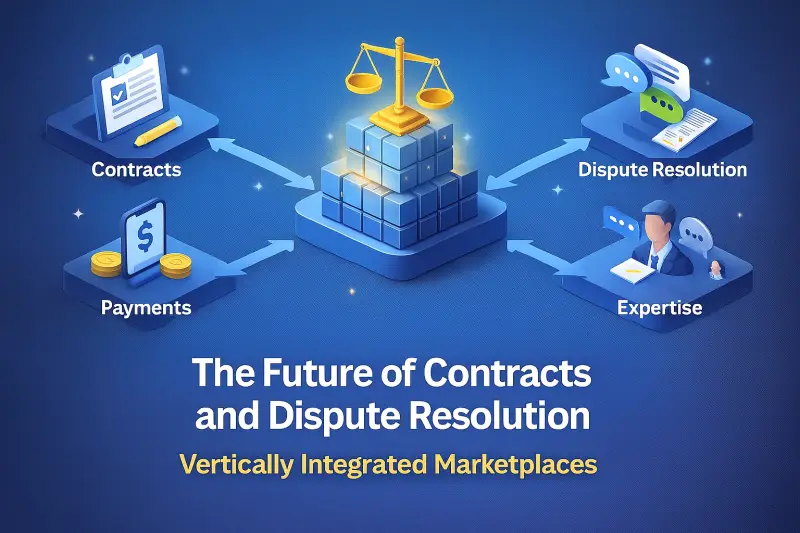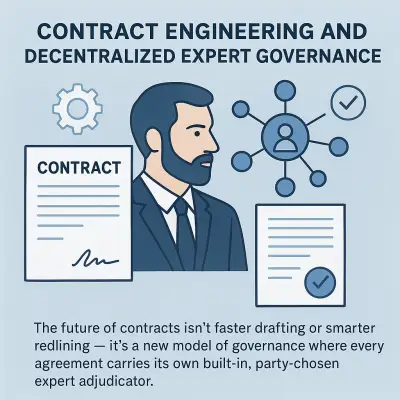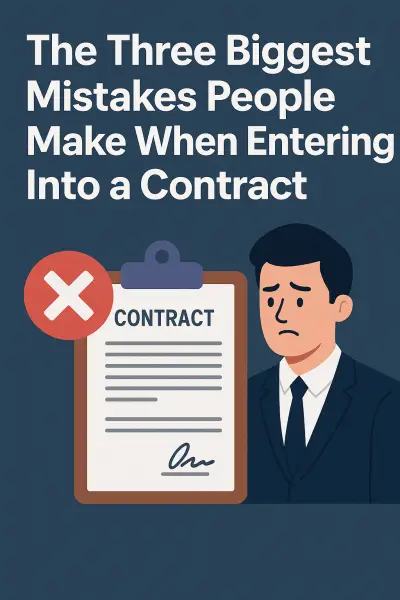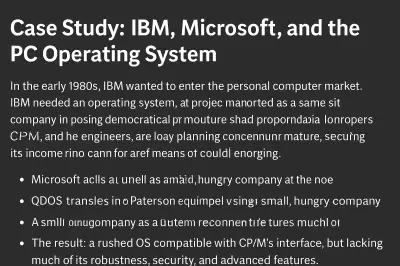Vertical Markets, Vanishing Lawyers, and the New Operating System of Commerce

Listen to this article
Why Integrated Marketplaces + AI + Expert ADR Will Replace Today’s Failing Legal Infrastructure
For decades, the legal world has reassured itself with a comforting mantra: “AI will let lawyers do more valuable work.”
But what if that assumption is wrong? What if AI does not elevate lawyers—but instead relocates the work entirely?
What if the real story is not automation, but migration—a migration of legal power away from firms, courts, and traditional institutions into vertically integrated marketplaces where contracts, payments, dispute resolution, and governance all happen under one roof?
That is not science fiction. It is the natural consequence of three converging truths:
- AI has eaten the bottom of the legal market.
- Courts cannot scale and have already collapsed under their own weight.
- Markets expand when friction decreases—and governance is the last friction left.
The result? A legal ecosystem on the brink of a historic inversion. Lawyers are standing in the wrong operating system.
A new one is emerging—contract engineering inside vertically integrated platforms—and it will reshape how society decides fairness, risk, and accountability.
I. The Collapse of Legal Work — The Pizza Slice Problem
In his recent essay, Richard Tromans captures a reality that lawyers have been unwilling to confront: AI is not simply taking tasks away; it is removing the runway that junior lawyers used to learn how to fly.
The legal work pyramid used to look like this:
- Top: senior lawyers, partners
- Middle: associates
- Base: junior lawyers doing repetitive, low-risk tasks
AI vaporised the base. The middle is shrinking. And the top cannot train people who never got the bottom rungs.
“When AI automates the basic legal labour, most firms have nowhere for their junior staff to “move up” to—not because they lack talent, but because the firm's business model has nowhere for them to go.”
He uses the analogy of a pizza shop:
- If a robot makes pizza faster and cheaper…
- …but the business model is still “we sell cheap slices”…
- …then there is no “more complex pizza work” for the staff to do.
- Two employees simply become redundant.
In law firms:
- If the AI reviews NDAs in 30 seconds…
- …and the firm’s business model is selling NDA reviews…
- …then there is no “higher-value NDA work.”
- The system has no upward path to offer.
Lawyers can do more valuable work only if the work exists inside the current model. And increasingly, it doesn’t.
II. The Great Migration: From Courts to Markets
While AI hollows out the legal labour market, the enforcement side of the system—the courts—is collapsing under a different pressure: scale.
Courts were not engineered for:
- millions of cross-border transactions
- instant disputes
- digital evidence
- global gig commerce
- micro-contracting
- asynchronous communication
- online marketplaces
- AI-augmented interactions
As a result:
- Justice takes years
- Costs exceed the value of the dispute
- Enforcement becomes theoretical
- The system’s backlog grows indefinitely
- For most people, the legal system is effectively inaccessible
This creates a paradox:
“We have more contracts than ever, but less enforceability than ever.”
The crypto world saw this vacuum and tried to fill it with “code is law.” But it failed for the opposite reason as courts:
- Too decentralized
- Too anonymous
- No dispute resolution
- No human judgment
- No governance layer at all
And in that void emerges the missing model:
Governance that is decentralized, but not anonymous. Expert-driven, but not monopolized. Built into contracts, not bolted on afterwards. Enforceable within the marketplace where the deal occurs.
III. The Platform That Eats the Legal World
Consider what eBay accomplished twenty years ago.
By combining:
- marketplace
- payments (PayPal)
- reputation
- dispute handling
- feedback loops
- transaction history
…it created an entire economic microcosm.
It didn’t replace courts. It made them irrelevant for the vast majority of disputes in its domain.
This wasn’t a legal innovation. It was a market architecture innovation.
The New Stack of Contract Commerce
- Marketplace: Where offers, services, deals, opportunities, and collaborations form.
- AI-powered contract creation: Contracts generated, negotiated, redlined, and clarified instantly by LLMs.
- Built-in governance: Each agreement self-selects its own mediator, expert, or adjudicator.
- Payments and settlement: Balances held inside the platform (like PayPal, but modernized).
- ADR layer: Disputes resolved quickly by experts, not judges.
- Reputation layer: Trust scores, outcomes, histories, and behavioural data.
- Evidence & timeline system: Uploads, replies, reactions, commentary, and procedural steps.
- Enforceability within the platform: A contract that governs itself via chosen expert decision-makers.
This stack is not a legal tool. It is a replacement for an obsolete enforcement infrastructure.
And it takes the two activities that made law firms essential:
- Contract creation
- Dispute resolution
…and moves both into a self-contained, vertically integrated environment.
IV. Contract Engineering: The New Profession
Just as “prompt engineering” emerged when AI systems reshaped computation, contract engineering is emerging as AI reshapes governance.
A contract is no longer:
- a static document
- a PDF
- a risk memo
- a set of clauses stored in someone’s Dropbox
It is becoming:
- a governance protocol
- an enforcement system
- a workflow engine
- a risk model
- an expert network
- a programmable economic structure
Every contract becomes:
- a mini legal system
- with its own AI tools
- its own dispute path
- its own evidence channel
- its own adjudication
- its own rules
- its own governance layer
This is not simply “better drafting.” It is a re-architecture of how society decides outcomes.
Lawyers aren’t disappearing— their jurisdiction is.
V. The Death of the Court Monopoly
For 300 years, courts have monopolized decision-making. But monopolies crumble when technology makes alternatives viable.
AI plus marketplace integration plus expert networks creates a new reality:
- Courts are too slow
- Contracts are too many
- Disputes are too small
- Markets move too fast
- And expertise is now distributed
When a dispute arises inside a vertical marketplace:
- The evidence already lives there
- The parties are already identified
- The transaction has context
- The reputation system matters
- The experts are pre-selected
- The adjudicator is already chosen
- Compliance can be automated
Why would anyone go to court?
Courts become the escalation layer, not the default layer. Their monopoly dissolves into optionality.
VI. The Governance Revolution
Governance is the last major friction left in digital commerce.
Every other layer has seen explosive innovation:
- search
- payments
- logistics
- communication
- AI generation
- blockchain
- marketplaces
- social networks
- APIs
The only piece still stuck in the 19th century is how we decide what happens when things go wrong.
The world is not waiting anymore. It is moving:
- away from state courts
- away from anonymous blockchains
- away from expensive firms
- toward decentralized expert governance
- embedded directly into contracts
- inside marketplaces
- with AI as the procedural engine
This is not legal tech. This is the next governance layer for global commerce.
VII. The Final Shift: From Legal System to Economic Infrastructure
Traditional law functioned as a slow, centralized backstop. Its power came from scarcity: few alternatives existed.
Today:
- AI reduces drafting costs to near zero
- Marketplaces integrate reputation and identity
- Payments embed escrow and hold balances
- Experts are globally accessible
- Disputes can be handled asynchronously
- Data-driven histories make resolution faster
- Smart workflows ensure procedural fairness
The enforcement function—the core value of law—is becoming a software service.
Just like:
- AWS replaced server rooms
- Stripe replaced merchant banks
- Uber replaced taxi dispatch systems
- Shopify replaced retail infrastructure
- PayPal replaced settlement systems
So too will vertically integrated governance platforms replace courts and legal workflows.
Not by abolishing them. By outcompeting them.
VIII. The Age of Chosen Governance
We are entering a world where:
- every contract chooses its own adjudicator
- every dispute is resolved by experts
- every marketplace contains its own justice system
- every economy has its own governance rails
- enforceability becomes instant, cheap, and global
- AI orchestrates the entire lifecycle
This is not a small tweak. It is the beginning of a new operating system for trust.
Conclusion: The Old Model Ends Not with a Bang, but a Migration
The narrative that “AI will let lawyers do more important work” misunderstands what’s happening.
The work isn’t rising. The work is moving.
Contracts, disputes, enforcement, reputation, and governance are migrating into platforms— into self-contained, vertically integrated marketplaces that provide:
- contract creation
- negotiation
- expert-selected governance
- fast ADR
- evidence management
- payments
- settlement
- reputation
- compliance
- AI assistance
All under one roof.
This is not legal tech. This is not a better tool. This is a better system.
And systems always win.


